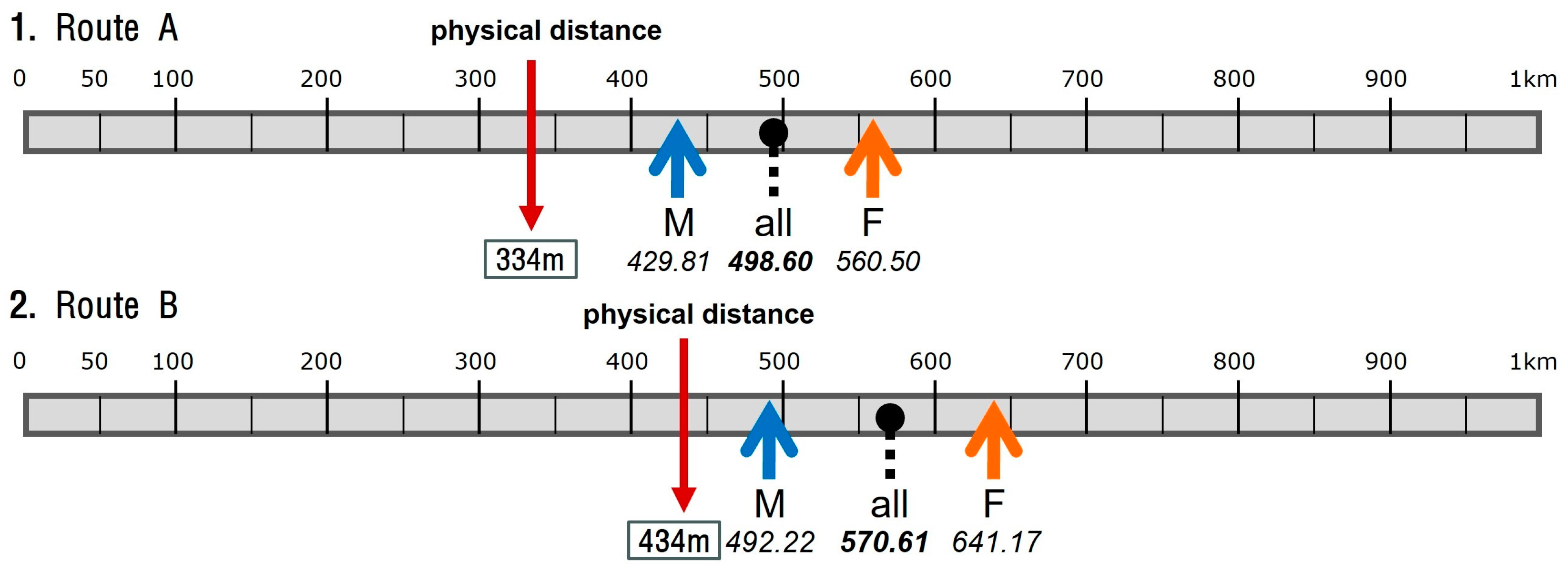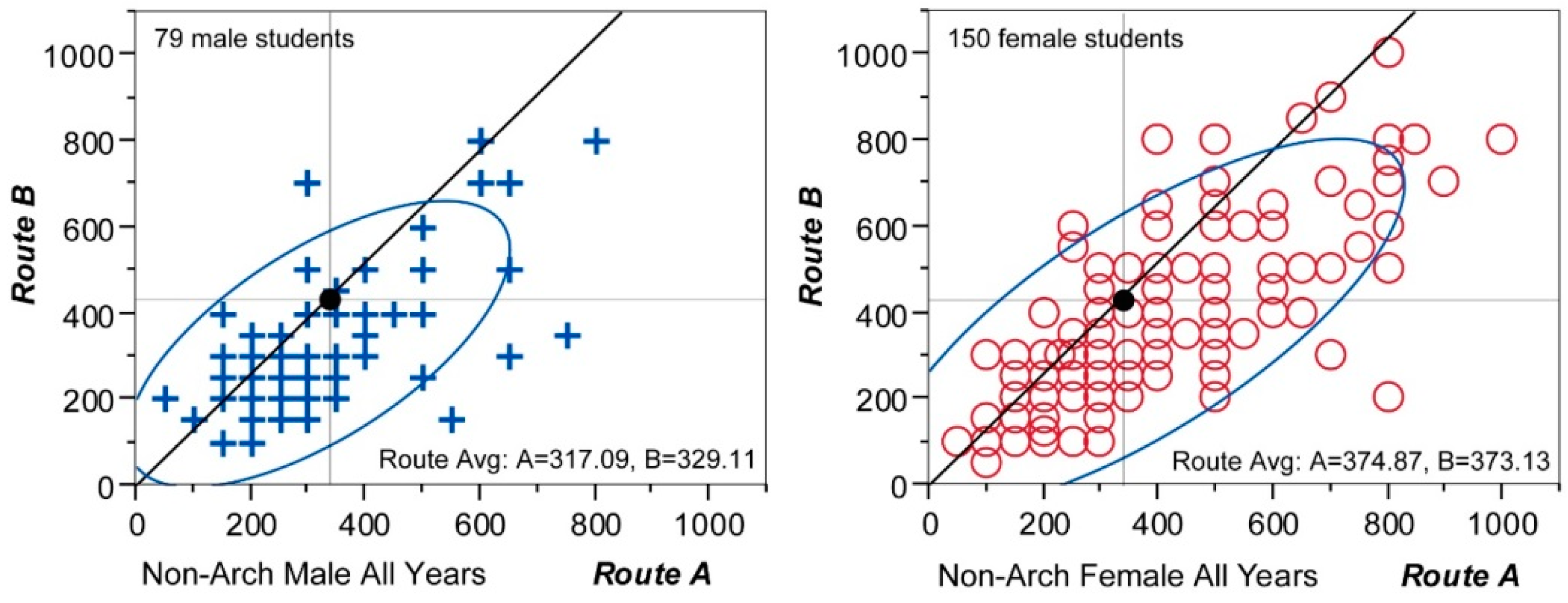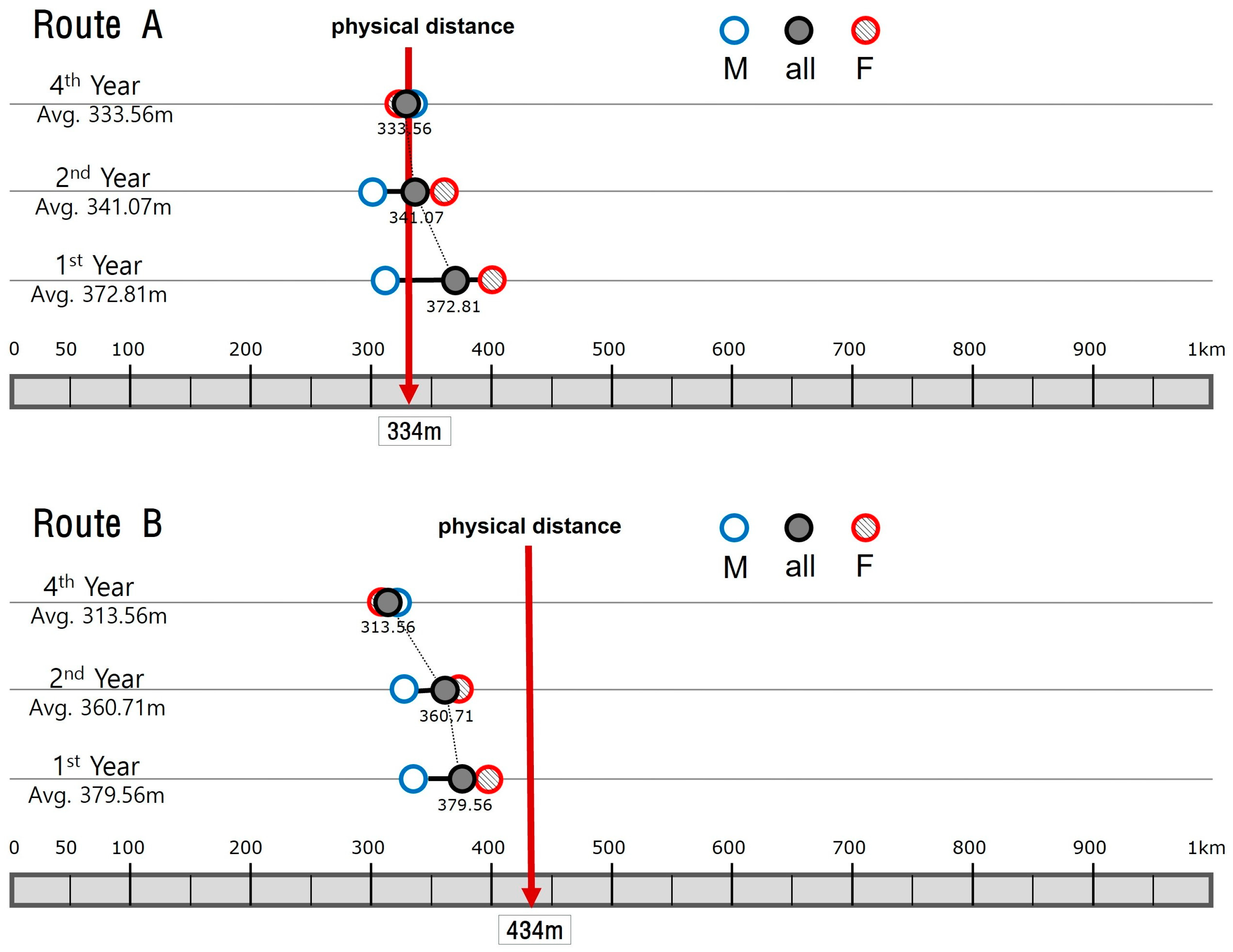Spatial Compression in Memory: How Repeated Walks on Familiar Routes Shorten Perceived Distance
Abstract
1. Introduction
2. Materials and Methods
3. Results
3.1. Sample 1 (Architecture Students)
3.2. Sample 2 (Non-Architecture Students)
4. Discussion
5. Conclusions
Author Contributions
Funding
Institutional Review Board Statement
Informed Consent Statement
Data Availability Statement
Acknowledgments
Conflicts of Interest
References
- Arslan, A. R., & Dazkir, S. S. (2017). Technical drafting and mental visualization in interior architecture education. International Journal for the Scholarship of Teaching and Learning, 11(2), 15. [Google Scholar] [CrossRef][Green Version]
- Berkowitz, M., Gerber, A., Thurn, C. M., Emo, B., Hoelscher, C., & Stern, E. (2020). Spatial abilities for architecture: Cross sectional and longitudinal assessment with novel and existing spatial ability tests. Frontiers in Psychology, 11, 609363. [Google Scholar] [CrossRef]
- Bilda, Z., & Gero, J. (2006). Reasoning with internal and external representations: A case study with expert architects. In R. Sun (Ed.), Proceedings of the annual meeting of cognitive science society (pp. 1020–1026). Lawrence Erlbaum Associates. [Google Scholar]
- Boltz, M. G., Kupperman, C., & Dunne, J. (1998). The role of learning in remembered duration. Memory & Cognition, 26, 903–921. [Google Scholar]
- Coeterier, J. F. (1994). Cues for the perception of size of space in landscape. Journal of Environmental Management, 42, 333–347. [Google Scholar] [CrossRef]
- Crompton, A. (2006). Perceived distance in the city as a function of time. Environment and Behavior, 38, 173–182. [Google Scholar]
- Goldreich, D., & Tong, J. (2013). Prediction, postdiction, and perceptual length contradiction: A Bayesian low-speed prior captures the cutaneous rabbit and related illusions. Frontiers in Psychology, 4, 221. [Google Scholar]
- Hammond, C. (2012). Time warped: Unlocking the mysteries of time perception. House of Anansi Press Inc. [Google Scholar]
- Hinds, P. J. (1999). The curse of expertise: The effects of expertise and debiasing methods on predictions of novice performance. Journal of Experimental Psychology: Applied, 5, 205–221. [Google Scholar] [CrossRef]
- Hsu, C., & Tsai, Y. (2014). An energy expenditure approach for estimating walking distance. Environment & Planning B, 41, 289–306. [Google Scholar]
- Kaplan, S. (1973). Cognitive maps in perception and thought. In R. M. Downs, & D. Stea (Eds.), Image and environment. Aldine Publishing Company. [Google Scholar]
- Lee, T. (1970). Perceived distance as a function of direction in the city. Environment and Behavior, 2, 40–51. [Google Scholar] [CrossRef]
- Montello, D. R. (1997). The perception and cognition of environmental distance: Direct sources of information. In S. C. Hirtle, & A. U. Frank (Eds.), Spatial information theory: A theoretical basis for GIS. Springer. [Google Scholar]
- Nasar, J. L. (1983). Environmental factors, perceived distance and spatial behavior. Environment and Planning B, 10, 275–281. [Google Scholar]
- Nasar, J. L., Valencia, H., Omar, Z. A., Chuer, S.-C., & Hwang, J.-H. (1985). Out of sight, further from mind: Destination visibility and distance perception. Environment and Behavior, 17, 627–639. [Google Scholar]
- Okabe, A., Aoki, K., & Hamamoto, W. (1986). Distance and direction judgment in a large scale natural environment. Environment and Behavior, 18, 755–772. [Google Scholar] [CrossRef]
- Platzer, E. (2005). Spatial Cognition research: The human navigation process and its comparability in complex real and virtual environments [Ph.D. Thesis, Universität der Bundeswehr München]. [Google Scholar]
- Roy, M. M., & Christenfeld, N. J. S. (2007). Bias in memory predicts bias in estimation of future task duration. Memory & Cognition, 35, 557–564. [Google Scholar]
- Roy, M. M., Mitten, T. S., & Christenfeld, N. J. S. (2008). Correcting memory improves accuracy of predicted duration. Journal of Experimental Psychology: Applied, 14, 266–275. [Google Scholar] [PubMed]
- Sadalla, E. K., & Magel, S. G. (1980). The perception of traversed distance. Environment and Behavior, 12, 65–79. [Google Scholar]
- Sadalla, E. K., & Staplin, L. J. (1980). The perception of traversed distance: Intersections. Environment and Behavior, 12, 167–182. [Google Scholar] [CrossRef]
- Seo, K. W. (2014). The distortion of road distance perception by the pattern of object distribution. KIEAE Journal, 14(4), 91–96. [Google Scholar] [CrossRef]
- van de Ven, N., van Rijswijk, L., & Roy, M. M. (2011). The return trip effect: Why the return trip often seems to take less time. Psychonomic Bulletin & Review, 18, 827–832. [Google Scholar]







Disclaimer/Publisher’s Note: The statements, opinions and data contained in all publications are solely those of the individual author(s) and contributor(s) and not of MDPI and/or the editor(s). MDPI and/or the editor(s) disclaim responsibility for any injury to people or property resulting from any ideas, methods, instructions or products referred to in the content. |
© 2025 by the authors. Licensee MDPI, Basel, Switzerland. This article is an open access article distributed under the terms and conditions of the Creative Commons Attribution (CC BY) license (https://creativecommons.org/licenses/by/4.0/).
Share and Cite
Seo, K.W.; Lee, H.-S.; Kim, J.Y. Spatial Compression in Memory: How Repeated Walks on Familiar Routes Shorten Perceived Distance. Behav. Sci. 2025, 15, 404. https://doi.org/10.3390/bs15040404
Seo KW, Lee H-S, Kim JY. Spatial Compression in Memory: How Repeated Walks on Familiar Routes Shorten Perceived Distance. Behavioral Sciences. 2025; 15(4):404. https://doi.org/10.3390/bs15040404
Chicago/Turabian StyleSeo, Kyung Wook, Hyung-Sook Lee, and Joo Young Kim. 2025. "Spatial Compression in Memory: How Repeated Walks on Familiar Routes Shorten Perceived Distance" Behavioral Sciences 15, no. 4: 404. https://doi.org/10.3390/bs15040404
APA StyleSeo, K. W., Lee, H.-S., & Kim, J. Y. (2025). Spatial Compression in Memory: How Repeated Walks on Familiar Routes Shorten Perceived Distance. Behavioral Sciences, 15(4), 404. https://doi.org/10.3390/bs15040404







